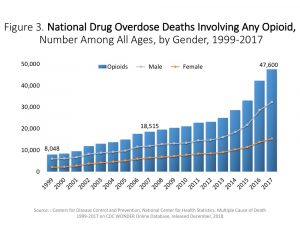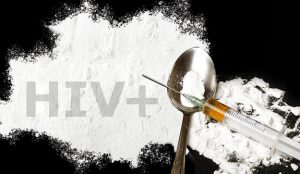In the last 15 years or so the use and abuse of opioids has become a worldwide problem. The Figure below shows the deaths from any opioid in the period 1999-2017. As we see the opioid deaths increased from a little over 8000 to more than 47000 and have continued to grow since then.
The main route of progression to hard core opioids such as heroin is through prescription opioids. The importance of this transition to the opioid epidemic has been studied through mathematical models in the following paper:
Battista, Nicholas A.; Pearcy, Leigh B.; Strickland, W. Christopher, Modeling the prescription opioid epidemic. Bull. Math. Biol. 81 (2019), no. 7, 2258–2289.
The opioid epidemic in general and the heroin epidemic in particular have been modeled with mathematical models extensively during these last 15-20 years. One of the early papers on modeling the heroin epidemic that developed the first opioid epidemic model is the following:
White, Emma; Comiskey, Catherine, Heroin epidemics, treatment and ODE modelling. Math. Biosci. 208 (2007), no. 1, 312–324.
Many of the more recent heroin models follow a similar flow-chart of the early opioid models. They consist of susceptibles, opioid-addicted, opioid-addicted-in-treatment classes.
Opioid use increases the chance of getting HIV. The HIV and Opioid epidemics are intertwined because (1) injecting drug users (IDU) may share a needle with an HIV infected person; (2) drug use lowers inhibitions and can lead to random sexual acts. HIV-infected individuals who use drugs have poorer health status. Co-infection of opioid use and HIV leads faster to death.
Although co-affection between HIV and opioid addiction are common, there are few mathematical models of both epidemics. The first mathematical models of the opioid and HIV were on within-host level modeling the dynamics of the opioid and HIV:
M. Mutua, A. S. Perelson, A. Kumar, N. K. Vaidya, Modeling the Effects of Morphine-Altered Virus Specific Antibody Responses on HIV/SIV Dynamics, Scientific Reports, Vol. 9, 5423 (2019) .
Mutua, F. Wang, N. K. Vaidya, Effects of Periodic Intake of Drugs of Abuse on HIV Dynamics: Mathematical Model and Analysis, Mathematical Biosciences, Vol. 326, 108395 (2020).
More recently between-host models were developed of the opioid and HIV epidemics: The risk of opioid users to get infected with hIV was investigated in:
Bloomquist, N. K. Vaidya, Modeling the Risk of HIV Infection for Drug Abusers, Journal of Biological Dynamics, pp. 1-24 (2020)
The dynamics of the two epidemics were investigated in a sequence of articles:
Duan, Xi-Chao; Li, Xue-Zhi; Martcheva, Maia; Coinfection dynamics of heroin transmission and HIV infection in a single population. J. Biol. Dyn. 14 (2020), no. 1, p. 116–142.
Gupta, Churni, Tuncer, Necibe, Martcheva, Maia, Immuno-epidemiological co-affection model of HIV infection and opioid addiction.Math. Biosci. Eng. 19 (2022), no. 4, 3636–3672.
The main results show that the invasion reproduction numbers are very sensitive to the coefficient of enhancement of HIV infection in addicted individuals as well as the rate of treatment of opioid-addicted individuals. This suggests that the most efficient control measures for combating these coupled epidemics is introducing measures that decrease the HIV-infection risk in opioid-affected individuals and treatment of addicted individuals. While these are the most effective control strategies, combining them with other control strategies, such as HIV treatment, certainly improves the outcomes.
For further information, please contact Maia Martcheva, Necibe Tuncer or Churni Gupta.
The authors acknowledge support from the National Science Foundation. All views are those of the authors and not of NSF.


